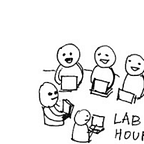By Mar Mcmahon
Recreating the Past: G̜̥̓͡l̡̋itc͉͔͐̒h̯͙͗͞ ̲̂A̬͉̙͚̾̍̓̆ř̨̝̳̄͐t̹͖̾̀̚ͅ (Glitch Art)
Zach Lieberman was away this week, so T.A. Matt Jacobson filled in this week to introduce us to glitch art. As a class, we examined the glitchy artwork of Rosa Menkman, whose website is truly bonkers.
Matt showed us some techniques for glitching up images in openFrameworks. One of these techniques was forEach-ing across file data to corrupt an image (Matt demonstrated, as always, on a photo of his strange little dog Bug). Matt also demonstrated pixel sorting, which was apparently quite popular on Tumblr a few years ago.
On a more abstract level, the question “what makes a glitch a glitch?” seemed to plague the class. In other words, how can glitch art be called glitch art if its glitches are intentional? Can a glitch be intentional?
Javi brought up the Adventure Time episode “A Glitch is a Glitch”, which was animated by occasional glitch artist David O’Reilly.
Dark Matters: Intro to Carceral Capitalism
Our reading this week was Jackie Wang’s Carceral Capitalism, which articulated some of the ways that the carceral state and capitalism depend on each other to self-sustain. During our class discussion, an unusually wide range of opinions surfaced in answering questions like: What should be the relationship between innocence and punishment? Should the state punish anyone? What does justice look like? What does restorative justice look like?
This is such a broad topic, but we tried to narrow the discussion in towards the ways that prison systems use technology to ruin people’s lives. We talked about what kinds of UI are used for incarcerated people (see SMARTJAILMAIL.COM), as well as digital surveillance and facial recognition (see Nabil’s essay Against Black Inclusion in Facial Recognition).
Hardware: Finally Some Motors!
Che-Wei finally brought in some motors! At the beginning of class, he showed us how to make rudimentary motors using only a battery, some wire, and a magnet. This task proved oddly frustrating for all of us, but by the end of class, all of us had gotten it to work for at least a moment.
We showed off sensor-based homework from the previous week. Projects included a computer that gets thirsty and “drinks” water; a wink detector, and a canvas that emits noise-art reacts to a marker on a string impacting it. Piezo sensors were the star of the show this week!
Scrapism: Working with Video
In Sam’s class, we learned how to manipulate video in Python scripts and in the command line using new tools. We used FFmpeg, a command line tool for manipulating video; youtube-dl, a tool for downloading YouTube vids; MoviePy, a Python module for video editing; and Sam’s own Videogrep, a tool that searches through the subtitles in YouTube videos to retrieve cuts. Sam used Videogrep in his CSPAN 5 project.
Professional Development
In preparation for our upcoming showcase (come to it!), Lauren walked us through the ins and outs of creating an installation. We learned to be over-specific with our material needs. We also had a little discussion about project descriptions. How much should a project “speak for itself” without becoming inaccessible? How can a project description enhance a piece?
We did a little exercise called “popcorning” where we paired off and asked each other for feedback and insight into our upcoming showcase projects. The rules of “popcorning” are simple: one person asks one question, then their partner gives three minutes of uninterrupted feedback. The exercise was a really nice way to prepare to make full use of each other as resources for the upcoming showcase. I noticed a lot of people asking for honest feedback about what themes seem to be coming up in their own work, which seemed to be a very productive question. Most of us can relate to having huge questions about how our work looks from outside of our own heads!
